American film star Bette Davis (1908-1989) was one of the greatest actors in world cinema history. She dared to play unsympathetic, sardonic characters and was reputed for her performances in a range of film genres, from contemporary crime melodramas to historical and period films and occasional comedies. Her greatest successes were her roles in romantic dramas.
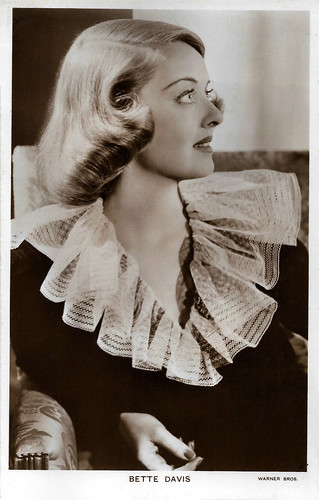
British postcard in the Picturegoer Series, London, no. W 3. Photo: Warner Bros.
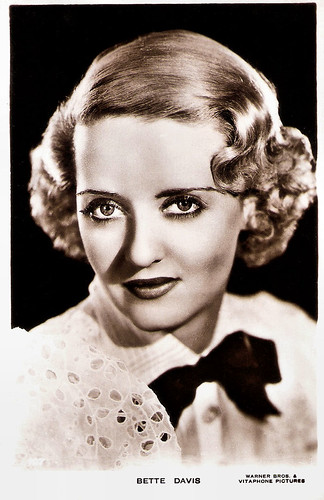
British Real Photograph postcard. Photo: Warner Bros. / Vitaphone Pictures.

British postcard. Photo: Warner Bros. Publicity still for The Letter (William Wyler, 1940).
Ruth Elizabeth Davis was born in 1908, in Lowell, Massachusetts, to Ruth Augusta (Favor) and Harlow Morrell Davis, a patent attorney. Her parents divorced when she was 10. She and her younger sister Barbara were raised by their mother. Her early interest was dance. To Bette, dancers led a glamorous life, but then she discovered the stage and gave up dancing for acting. To her, it presented much more of a challenge.
After graduation from Cushing Academy, a prep school in Ashburnham, Massachusetts, Davis was refused admittance to Eva Le Gallienne's Manhattan Civic Repertory. She enrolled in John Murray Anderson's Dramatic School where everyone (including classmate Lucille Ball) regarded her as the star pupil. After a 1928 summer season with director George Cukor's stock company in Rochester, N.Y. (where she worked with future co-star - and rival - Miriam Hopkins), Davis went on to New York. Her Broadway debut was in Broken Dishes (1929) and she also appeared in Solid South. In 1930, Davis moved to Hollywood and signed a contract with Universal. Her first film was the drama Way Back Home (William A. Seiter, 1931). Her early films for Universal were unsuccessful or she only had a small role, such as in James Whale's Waterloo Bridge (1931). Davis later recalled Universal Pictures executive Carl Laemmle Jr. complaining: "She's got as much sex appeal as Slim Summerville".
Davis was preparing to return to New York when actor George Arliss chose her for the female lead in the Warner Brothers picture The Man Who Played God (John G. Adolfi, 1932), which would be her 'break' in Hollywood. Warner Bros. signed her a five-year (Wikipedia) or a seven-year contract (IMDb). Her first film with them had been Seed (John M. Stahl, 1931), starring John Boles. The role of the vicious and slatternly Mildred Rogers in RKO's Of Human Bondage (John Cromwell, 1934) earned Davis her first major critical acclaim. She had a significant number of write-in votes for the Best Actress Oscar but didn't win. For her role as a troubled actress in Dangerous (Alfred E. Green, 1935), she won her first Oscar. With this success under her belt, she began pushing Warner for stronger and more meaningful roles.
In 1936, she was suspended without pay for turning down a role that she deemed unworthy of her talent. She went to England, where she had planned to make films, but was stopped by Warner Bros. because she was still under contract to them and they did not want her to work anywhere. Although she sued to get out of her contract, she lost a well-publicised legal case. Still, Warner began to take her more seriously after that, and the lawsuit marked the beginning of the most successful period of her career. In Marked Woman (Lloyd Bacon, 1937), she played a prostitute in a contemporary gangster drama inspired by the case of Lucky Luciano. For her role, she was awarded the Volpi Cup at the 1937 Venice Film Festival. Her next picture was Jezebel (William Wyler, 1938) with Henry Fonda, and during production, Davis entered a relationship with director William Wyler. The film was a success, and Davis' performance as a spoiled Southern Belle earned her a second Academy Award.
In 1939 alone, Davis starred in Dark Victory (Edmund Goulding, 1939), Juarez (William Dieterle, 1939) with Paul Muni, The Private Lives of Elizabeth and Essex (Michael Curtiz, 1939) with Errol Flynn, and The Old Maid (Edmund Goulding, 1939) with Miriam Hopkins. Dark Victory (became one of the highest-grossing films of the year, and the role of Judith Traherne brought her an Academy Award nomination. The Private Lives of Elizabeth and Essex was her first colour film. To play the elderly Elizabeth I of England, Davis shaved her hairline and eyebrows. Davis was now Warner Bros.'s most profitable star, and she was given the most important of their female leading roles. Her image was considered with care; she was often filmed in close-ups that emphasised her distinctive eyes.
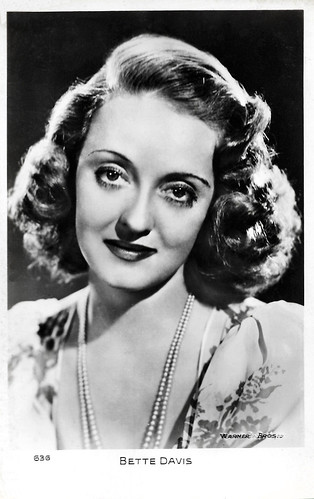
French postcard by Editions Chantal, Paris, no. 636. Photo: Warner Bros.
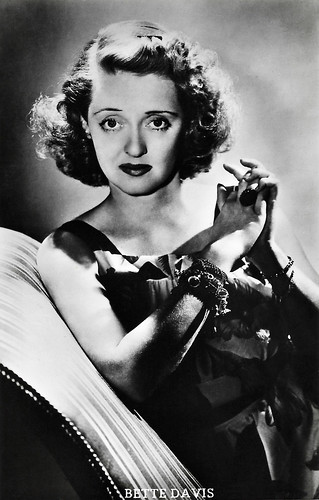
Dutch postcard, no. 550. Photo: Warner Bros.
Until the late 1940s, Bette Davis was one of American cinema's most celebrated leading ladies, known for her forceful and intense style. Davis gained a reputation as a perfectionist who could be highly combative, and confrontations with studio executives, film directors and co-stars were often reported. After The Letter (William Wyler, 1940), William Wyler directed Davis for the third time in Lillian Hellman's The Little Foxes (1941), but they clashed over the character of Regina Giddens. Taking a role originally played on stage by Tallulah Bankhead, Davis felt Bankhead's original interpretation was appropriate and followed Hellman's intent, but Wyler wanted her to soften the character. Davis refused to compromise. Davis's forthright manner, clipped vocal style and ubiquitous cigarette contributed to a public persona which has often been imitated and satirised. In 1941, she became the first female president of the Academy of Motion Picture Arts and Sciences and a year later, she was the co-founder of the Hollywood Canteen. Her best films include the women's picture Now Voyager (Irving Rapper, 1942) and Watch on the Rhine (Herman Shumlin, 1943). She was nominated for an Academy Award 5 years in a row, in 1939, 1940, 1941, 1942 and 1943.
In 1947, at the age of 39, Davis gave birth to a daughter, Barbara Davis Sherry (known as B.D.). The father, her third husband William Grant Sherry, later divorced her to marry their child's governess Marion Richards. Bette Davis made many successful films in the 1940s, but each picture was weaker than the last. In 1949, Davis was so unhappy over being cast in Beyond the Forest (King Vidor, 1949) with Joseph Cotten that she threatened Warner Bros. studio chief Jack L. Warner that she would walk off the production with the film only half finished. Warner was forced to cancel her contract and Davis completed the film, ending 18 years with the studio. By that time, her box office appeal had noticeably dropped and she was labelled 'Box Office Poison'. Then producer Darryl F. Zanuck offered her the role of the ageing theatrical actress Margo Channing in All About Eve (Joseph L. Mankiewicz, 1950). During production, she had a romantic relationship with her leading man, Gary Merrill, which led to her fourth marriage. Her career went through several such periods of eclipse. In 1961 she even placed a now famous Job Wanted ad in the trade papers. Later, Davis admitted that her success had often been at the expense of her personal relationships. Married four times, she was once widowed and thrice divorced and raised her children as a single parent.
Later successes include the Grand Guignol horror film What Ever Happened to Baby Jane? (Robert Aldrich, 1962) with Joan Crawford, and the follow-up Hush… Hush, Sweet Charlotte (Robert Aldrich, 1964) with Olivia de Havilland. Reportedly, Joan Crawford and Davis had feuded for years, some of it instigated by publicists and studio heads. During the making of What Ever Happened to Baby Jane? (1962), Bette had a Coca-Cola machine installed on the set due to Crawford's affiliation with Pepsi (she was the widow of Pepsi's CEO). Joan got her revenge by putting weights in her pockets when Davis had to drag her across the floor during certain scenes. While promoting the film, Davis told one interviewer that when she and Crawford were first suggested for the leads, Warner studio head Jack L. Warner replied: "I wouldn't give a plugged nickel for either of those two old broads." Recalling the story, Davis laughed at her own expense. The following day, she received a telegram from Crawford: "In future, please do not refer to me as an old broad!".
Bette Davis' final years were marred by a long period of ill health, but she continued acting until shortly before her death from breast cancer, with more than 100 films, television and theatre roles to her credit. She was the first person to accrue 10 Academy Award nominations for acting, and in 1977, she was the first woman to receive a Lifetime Achievement Award from the American Film Institute. In 1979 she won a Best Actress Emmy for Strangers: The Story of a Mother and Daughter (Milton Katselas, 1979) with Gena Rowlands. One of her last films was Lindsay Anderson's film The Whales of August (1987), in which she played the blind sister of Lillian Gish.
Bette Davis died in 1989, of metastasised breast cancer, in Neuilly-sur-Seine, Hauts-de-Seine, France. A lot of her fans refused to believe it. She reportedly left an estate valued between $600,000 and $1 million, consisting mainly of a condominium apartment she owned in West Hollywood. 50% of her estate went to her son, Michael Merrill, and the remaining 50% went to her secretary and companion, Kathryn Sermack. Her daughter, Barbara Merrill aka B.D. Hyman, was left nothing due to her tell-all book My Mother's Keeper about life with her mother. (Davis wrote the book This 'n That in response to her daughter's book.) And IMDb notes that Bette Davis's false eyelashes were auctioned off after her death, fetching a price of $600.
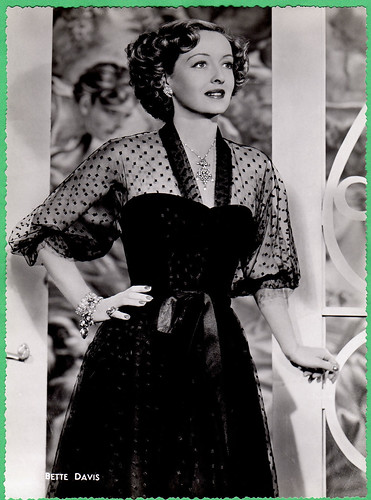
Belgian collectors card by Chocolaterie Clovis, Pepinster. Collection: Amit Benyovits.
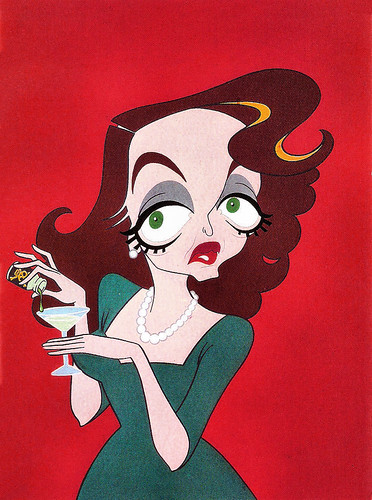
British postcard by Athena International, London, no. 9244. Illustration: Oscar da Costa.
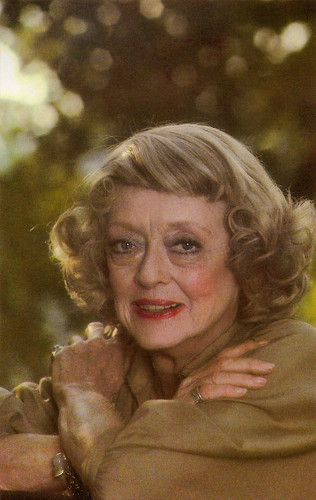
American postcard by Coral-Lee, Rancho Cordova, CA, no. Personality # 89, 1979, no. SC17839. Photo: Douglas Kirkland / Contact.
Sources: Hal Erickson (AllMovie), Wikipedia and IMDb.
This post was last updated on 2 December 2023.

British postcard in the Picturegoer Series, London, no. W 3. Photo: Warner Bros.

British Real Photograph postcard. Photo: Warner Bros. / Vitaphone Pictures.

British postcard. Photo: Warner Bros. Publicity still for The Letter (William Wyler, 1940).
Emphasising her distinctive eyes
Ruth Elizabeth Davis was born in 1908, in Lowell, Massachusetts, to Ruth Augusta (Favor) and Harlow Morrell Davis, a patent attorney. Her parents divorced when she was 10. She and her younger sister Barbara were raised by their mother. Her early interest was dance. To Bette, dancers led a glamorous life, but then she discovered the stage and gave up dancing for acting. To her, it presented much more of a challenge.
After graduation from Cushing Academy, a prep school in Ashburnham, Massachusetts, Davis was refused admittance to Eva Le Gallienne's Manhattan Civic Repertory. She enrolled in John Murray Anderson's Dramatic School where everyone (including classmate Lucille Ball) regarded her as the star pupil. After a 1928 summer season with director George Cukor's stock company in Rochester, N.Y. (where she worked with future co-star - and rival - Miriam Hopkins), Davis went on to New York. Her Broadway debut was in Broken Dishes (1929) and she also appeared in Solid South. In 1930, Davis moved to Hollywood and signed a contract with Universal. Her first film was the drama Way Back Home (William A. Seiter, 1931). Her early films for Universal were unsuccessful or she only had a small role, such as in James Whale's Waterloo Bridge (1931). Davis later recalled Universal Pictures executive Carl Laemmle Jr. complaining: "She's got as much sex appeal as Slim Summerville".
Davis was preparing to return to New York when actor George Arliss chose her for the female lead in the Warner Brothers picture The Man Who Played God (John G. Adolfi, 1932), which would be her 'break' in Hollywood. Warner Bros. signed her a five-year (Wikipedia) or a seven-year contract (IMDb). Her first film with them had been Seed (John M. Stahl, 1931), starring John Boles. The role of the vicious and slatternly Mildred Rogers in RKO's Of Human Bondage (John Cromwell, 1934) earned Davis her first major critical acclaim. She had a significant number of write-in votes for the Best Actress Oscar but didn't win. For her role as a troubled actress in Dangerous (Alfred E. Green, 1935), she won her first Oscar. With this success under her belt, she began pushing Warner for stronger and more meaningful roles.
In 1936, she was suspended without pay for turning down a role that she deemed unworthy of her talent. She went to England, where she had planned to make films, but was stopped by Warner Bros. because she was still under contract to them and they did not want her to work anywhere. Although she sued to get out of her contract, she lost a well-publicised legal case. Still, Warner began to take her more seriously after that, and the lawsuit marked the beginning of the most successful period of her career. In Marked Woman (Lloyd Bacon, 1937), she played a prostitute in a contemporary gangster drama inspired by the case of Lucky Luciano. For her role, she was awarded the Volpi Cup at the 1937 Venice Film Festival. Her next picture was Jezebel (William Wyler, 1938) with Henry Fonda, and during production, Davis entered a relationship with director William Wyler. The film was a success, and Davis' performance as a spoiled Southern Belle earned her a second Academy Award.
In 1939 alone, Davis starred in Dark Victory (Edmund Goulding, 1939), Juarez (William Dieterle, 1939) with Paul Muni, The Private Lives of Elizabeth and Essex (Michael Curtiz, 1939) with Errol Flynn, and The Old Maid (Edmund Goulding, 1939) with Miriam Hopkins. Dark Victory (became one of the highest-grossing films of the year, and the role of Judith Traherne brought her an Academy Award nomination. The Private Lives of Elizabeth and Essex was her first colour film. To play the elderly Elizabeth I of England, Davis shaved her hairline and eyebrows. Davis was now Warner Bros.'s most profitable star, and she was given the most important of their female leading roles. Her image was considered with care; she was often filmed in close-ups that emphasised her distinctive eyes.

French postcard by Editions Chantal, Paris, no. 636. Photo: Warner Bros.

Dutch postcard, no. 550. Photo: Warner Bros.
Labelled 'box office poison'
Until the late 1940s, Bette Davis was one of American cinema's most celebrated leading ladies, known for her forceful and intense style. Davis gained a reputation as a perfectionist who could be highly combative, and confrontations with studio executives, film directors and co-stars were often reported. After The Letter (William Wyler, 1940), William Wyler directed Davis for the third time in Lillian Hellman's The Little Foxes (1941), but they clashed over the character of Regina Giddens. Taking a role originally played on stage by Tallulah Bankhead, Davis felt Bankhead's original interpretation was appropriate and followed Hellman's intent, but Wyler wanted her to soften the character. Davis refused to compromise. Davis's forthright manner, clipped vocal style and ubiquitous cigarette contributed to a public persona which has often been imitated and satirised. In 1941, she became the first female president of the Academy of Motion Picture Arts and Sciences and a year later, she was the co-founder of the Hollywood Canteen. Her best films include the women's picture Now Voyager (Irving Rapper, 1942) and Watch on the Rhine (Herman Shumlin, 1943). She was nominated for an Academy Award 5 years in a row, in 1939, 1940, 1941, 1942 and 1943.
In 1947, at the age of 39, Davis gave birth to a daughter, Barbara Davis Sherry (known as B.D.). The father, her third husband William Grant Sherry, later divorced her to marry their child's governess Marion Richards. Bette Davis made many successful films in the 1940s, but each picture was weaker than the last. In 1949, Davis was so unhappy over being cast in Beyond the Forest (King Vidor, 1949) with Joseph Cotten that she threatened Warner Bros. studio chief Jack L. Warner that she would walk off the production with the film only half finished. Warner was forced to cancel her contract and Davis completed the film, ending 18 years with the studio. By that time, her box office appeal had noticeably dropped and she was labelled 'Box Office Poison'. Then producer Darryl F. Zanuck offered her the role of the ageing theatrical actress Margo Channing in All About Eve (Joseph L. Mankiewicz, 1950). During production, she had a romantic relationship with her leading man, Gary Merrill, which led to her fourth marriage. Her career went through several such periods of eclipse. In 1961 she even placed a now famous Job Wanted ad in the trade papers. Later, Davis admitted that her success had often been at the expense of her personal relationships. Married four times, she was once widowed and thrice divorced and raised her children as a single parent.
Later successes include the Grand Guignol horror film What Ever Happened to Baby Jane? (Robert Aldrich, 1962) with Joan Crawford, and the follow-up Hush… Hush, Sweet Charlotte (Robert Aldrich, 1964) with Olivia de Havilland. Reportedly, Joan Crawford and Davis had feuded for years, some of it instigated by publicists and studio heads. During the making of What Ever Happened to Baby Jane? (1962), Bette had a Coca-Cola machine installed on the set due to Crawford's affiliation with Pepsi (she was the widow of Pepsi's CEO). Joan got her revenge by putting weights in her pockets when Davis had to drag her across the floor during certain scenes. While promoting the film, Davis told one interviewer that when she and Crawford were first suggested for the leads, Warner studio head Jack L. Warner replied: "I wouldn't give a plugged nickel for either of those two old broads." Recalling the story, Davis laughed at her own expense. The following day, she received a telegram from Crawford: "In future, please do not refer to me as an old broad!".
Bette Davis' final years were marred by a long period of ill health, but she continued acting until shortly before her death from breast cancer, with more than 100 films, television and theatre roles to her credit. She was the first person to accrue 10 Academy Award nominations for acting, and in 1977, she was the first woman to receive a Lifetime Achievement Award from the American Film Institute. In 1979 she won a Best Actress Emmy for Strangers: The Story of a Mother and Daughter (Milton Katselas, 1979) with Gena Rowlands. One of her last films was Lindsay Anderson's film The Whales of August (1987), in which she played the blind sister of Lillian Gish.
Bette Davis died in 1989, of metastasised breast cancer, in Neuilly-sur-Seine, Hauts-de-Seine, France. A lot of her fans refused to believe it. She reportedly left an estate valued between $600,000 and $1 million, consisting mainly of a condominium apartment she owned in West Hollywood. 50% of her estate went to her son, Michael Merrill, and the remaining 50% went to her secretary and companion, Kathryn Sermack. Her daughter, Barbara Merrill aka B.D. Hyman, was left nothing due to her tell-all book My Mother's Keeper about life with her mother. (Davis wrote the book This 'n That in response to her daughter's book.) And IMDb notes that Bette Davis's false eyelashes were auctioned off after her death, fetching a price of $600.

Belgian collectors card by Chocolaterie Clovis, Pepinster. Collection: Amit Benyovits.

British postcard by Athena International, London, no. 9244. Illustration: Oscar da Costa.

American postcard by Coral-Lee, Rancho Cordova, CA, no. Personality # 89, 1979, no. SC17839. Photo: Douglas Kirkland / Contact.
Sources: Hal Erickson (AllMovie), Wikipedia and IMDb.
This post was last updated on 2 December 2023.
No comments:
Post a Comment